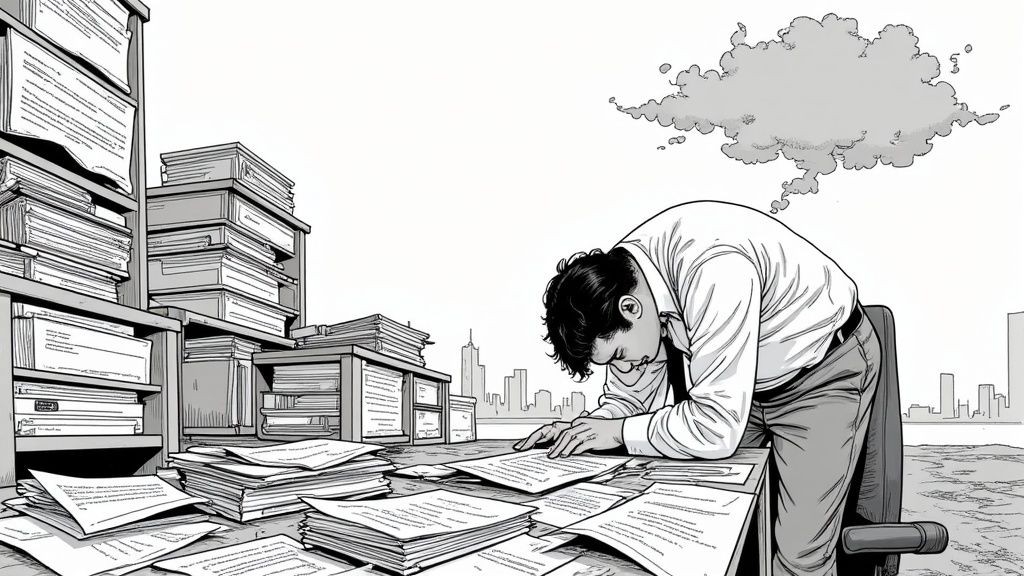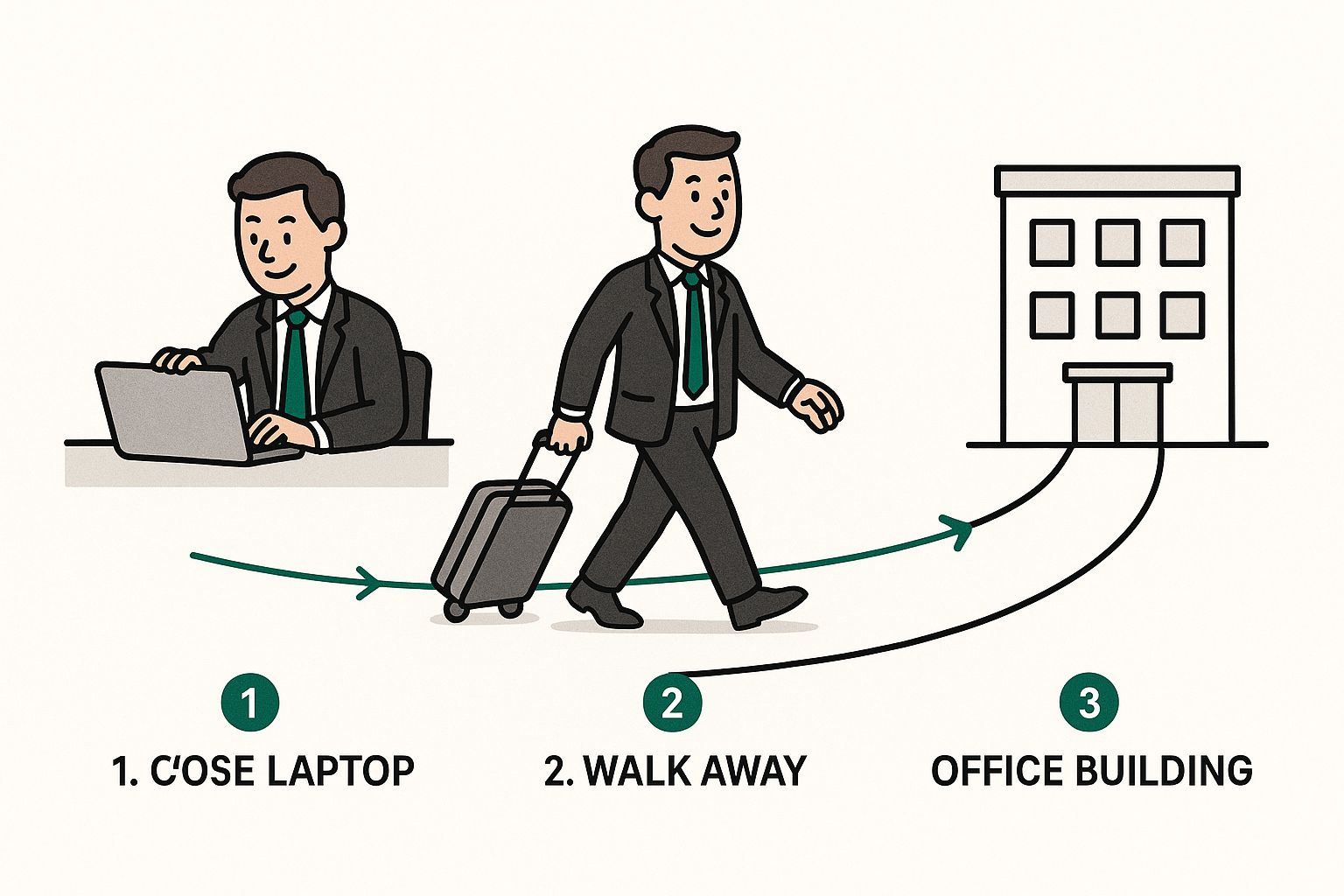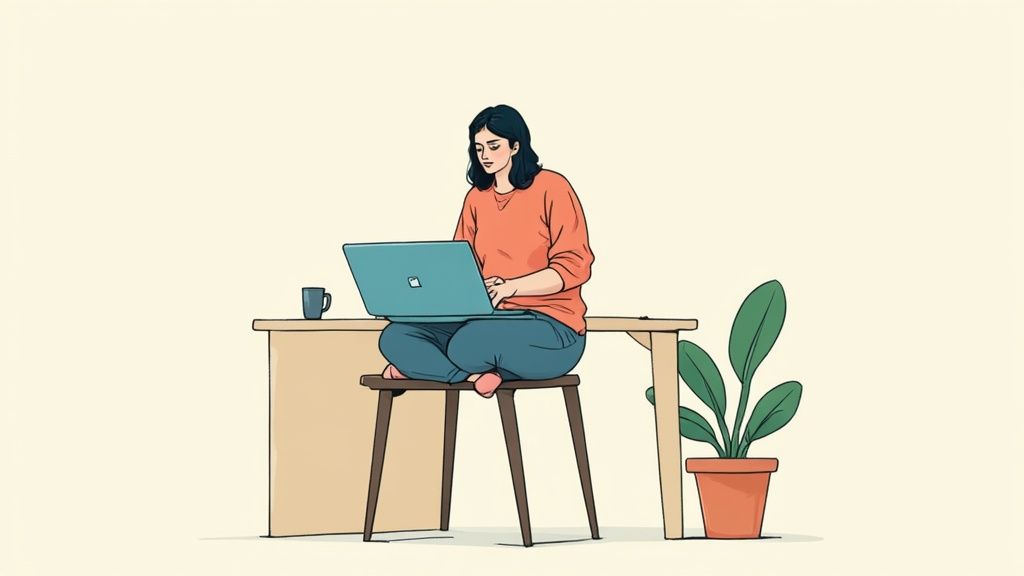
A Practical Guide to Taking Stress Work Leave
Posted by Robin on 02 Oct, 2025 in
Taking a step back with stress leave means taking a formal, approved period of absence from your job.It's your chance to recover from work-related stress, anxiety, or full-blown burnout. Think of it as a recognised medical leave, often backed by a doctor's fit note, and it's absolutely vital for preventing more serious, long-term health problems down the line.
Recognising the Signs You Need a Break

It’s all too easy to brush off feeling constantly drained as just another tough week. But the signs that you genuinely need a proper break often run much deeper than just feeling tired.
These signals can start subtly but tend to get louder over time. Before you know it, they're impacting your physical health, your emotional wellbeing, and even how you act in ways you might not spot at first.
For example, a graphic designer might suddenly find their passion has evaporated, replaced by a constant sense of dread or a complete creative block. Or a team leader, usually calm and collected, might become unusually irritable, snapping at colleagues over minor things or finding it impossible to focus in meetings. These aren't just off days; they are often tangible symptoms of burnout creeping in.
Physical and Emotional Red Flags
Your body and mind are pretty good at sending up warning flares when they're overwhelmed. The trick is to recognise them before you hit a crisis point.
Look out for these key signs:
- Persistent Physical Symptoms: Are you dealing with constant headaches, digestive problems, or that stubborn muscle tension in your neck and shoulders that just won't quit?
- Emotional Exhaustion: This can feel like cynicism about your job, a sense of detachment from your work, or losing interest in hobbies you used to love.
- Cognitive Difficulties: Maybe you're struggling to concentrate, forgetting things, or finding that simple decisions suddenly feel monumental.
These symptoms are more common than you might think. During 2023/24 in Great Britain, work-related stress and anxiety were the number one reason for sick days, leading to a staggering 16.4 million lost working days. It's a huge issue, and you can see the full workplace health statistics on the Health and Safety Executive website.
The biggest tell-tale sign is when the stress simply doesn't switch off. If you're spending your evenings and weekends worrying about work, unable to be present with family or friends, it’s a clear signal that a boundary has been crossed and you need to recover.
Understanding these signals is crucial for everyone, from employees to managers. If you're looking for more guidance on this, our article on the https://blog.leavetrackapp.com/articles/top-5-signs-you-need-help-with-employee-absence is a great place to start.
How to Talk to Your Manager About Leave
Bringing up the topic of stress work leave with your manager can feel seriously daunting. I've seen many people struggle with this, but the key to a smoother conversation is always preparation. Going in with a clear head will help you approach the discussion with confidence.
Your main goal here is to frame this as a health issue, not as a laundry list of complaints about your job. Before you even think about booking a meeting, it's a really good idea to have a chat with your GP. Getting a professional medical opinion doesn't just validate what you're feeling; it gives you a much clearer picture of what you need, which instantly strengthens your case.
This visual breaks down the journey from that initial realisation that you need a break to actually taking that time to heal.

As you can see, closing the laptop is really just the beginning of the road to recovery.
Structuring the Conversation
When it's time to talk to your manager, try to keep your tone calm and professional. You absolutely do not need to share every single detail of your struggles unless you feel comfortable doing so. The conversation should centre on your fitness to work and the necessity of taking time to recover.
Here are a few ways you could open the conversation:
- "I'm really committed to my role here, but my health has taken a hit recently, and it's starting to impact my ability to do my best work."
- "On the advice of my doctor, I need to request some time off to focus on my health and get back on track."
- "Before I take my leave, I want to work closely with you to make sure all my responsibilities are handed over smoothly."
To help you organise your thoughts, I've put together a simple checklist for that conversation. Walking through these steps beforehand can make a world of difference.
Conversation Checklist for Requesting Stress Leave
| Preparation Step | Key Action | Why It's Important |
|---|---|---|
| Consult Your GP | Get a medical opinion or a doctor's note before the meeting. | This provides professional validation and clarifies the medical necessity for your leave. |
| Know Your Rights | Briefly review your company's sick leave and mental health policies. | Understanding the official procedure shows you've done your homework and are following protocol. |
| Pick the Right Time | Schedule a private meeting. Avoid ambushing your manager or bringing it up during a stressful time. | A dedicated, private space ensures a focused and confidential conversation without distractions. |
| Draft Your Talking Points | Jot down the key things you want to say. Use the examples above as a starting point. | This keeps you from getting flustered and ensures you communicate your needs clearly and calmly. |
| Prepare a Handover Plan | Think about your current projects and outline a basic plan for who could cover them. | This shows proactivity and a commitment to the team, making it easier for your manager to say yes. |
| Anticipate Questions | Be ready to discuss potential timelines and how your work will be managed in your absence. | Being prepared for likely questions demonstrates foresight and helps move the conversation toward a solution. |
Walking into the room prepared isn't just about showing your manager you're on top of things; it's about giving yourself the confidence to ask for what you need.
The most powerful way to approach this is to present your request as a proactive step for your long-term health and productivity. This immediately reframes the situation from being a problem into being a solution, encouraging support instead of defensiveness.
Be ready for questions about how long you'll be away and who will handle your duties. Having a rough plan in mind shows you're being responsible and makes it much simpler for your manager to approve your request. If you need more practical advice, this guide on how to talk about mental health with confidence has some fantastic insights for framing these discussions in a constructive way.
Understanding Your Rights and Company Policies

The last thing you need when you're feeling overwhelmed is more stress from navigating paperwork and procedures. Getting your head around your rights and your company’s rules is the first, most crucial step to managing this process calmly.
Here in the UK, you have legal protections in place. If you find yourself needing more than seven consecutive days off work because of stress, you'll need to get a ‘fit note’ from your GP. This isn't just a formality; it's the key document that officially confirms your need to be off and allows you to access Statutory Sick Pay (SSP), which is your baseline financial support.
There’s also the Equality Act 2010, which offers a significant layer of protection. If your stress is linked to a long-term mental health condition that substantially affects your day-to-day life, it could be classified as a disability. This is a big deal because it means your employer has a legal duty to make reasonable adjustments for you, both while you’re off and when you return.
Finding and Making Sense of Your Company’s Policy
Beyond the law, your employer’s own policies are your next port of call. Have a dig around on the company intranet for documents like a “Sickness Absence Policy” or the general “Employee Handbook.” If you can't find them, a quick, confidential email to HR will get you a copy.
These documents are where you’ll find the specifics, like:
- Company Sick Pay: Many companies offer more than the statutory minimum, which can make a huge difference financially.
- Reporting Procedures: The step-by-step process you must follow when you call in sick.
- Support Programmes: Details on whether you have access to things like an Employee Assistance Programme (EAP) or occupational health services.
Remember, company policies can add to your rights, but they can never take away what you’re legally entitled to. Knowing both gives you the complete picture of the support you can expect.
Understanding this is so important, especially when you look at the bigger picture. Mental health issues are now the top reason for workplace absence in the UK. Stress and anxiety alone account for a staggering 16.4 million lost working days every single year.
It’s clear that managing this proactively is vital for everyone involved. For businesses looking to get on top of this, our guide can help simplify leave management with a template annual leave policy.
Making the Most of Your Time Off for a Real Recovery
Let's be clear: genuine recovery from workplace stress isn’t about finally tackling that mountain of life admin or being 'productive' in other ways. It’s about intentional rest, and that starts by drawing a firm line in the sand between you and your job. Resisting the urge to do a ‘quick check-in’ on emails isn't just a good idea—it's non-negotiable if you want this time off to actually work.
Your time away shouldn't be dictated by a to-do list. Think of it as a chance to find your balance again. What this looks like is deeply personal. For some, it might mean finally seeking professional support through therapy to get to the root of their stress. For others, it’s about reconnecting with a hobby they once loved, whether that’s painting, gardening, or picking up a musical instrument.
Building a Gentle Routine
Recovery thrives on structure, but not the rigid, demanding kind you’re trying to escape. A simple daily routine can be incredibly grounding. We’re not talking about a complex, minute-by-minute schedule here; it's about creating gentle, predictable rhythms that help calm your nervous system.
This could be as simple as:
- Starting your day with a short walk outside instead of scrolling on your phone.
- Scheduling a specific time for some light physical activity, like stretching or yoga.
- Setting aside 20 minutes each day to read a book or listen to some calming music.
The whole point is to swap out those ingrained work-related habits for activities that truly nourish your wellbeing. If you're looking for a structured way to manage stress during your leave, exploring something like Mindfulness-Based Stress Reduction (MBSR) can be a fantastic option.
Remember, recovery is not a straight line. Some days will feel much easier than others, and that’s perfectly okay. The goal isn’t perfection; it’s about gentle consistency in putting your mental and emotional health first.
Navigating this takes patience with yourself. By focusing on small, restorative actions each day, you’ll start to rebuild the resilience needed not just to go back to work, but to thrive there in the long run. This period is a crucial investment in your future health.
Planning a Successful Return to Work
Heading back into the very environment that might have contributed to your stress is a delicate process. It needs a careful, considered strategy. Just jumping back into your old routine as if nothing happened is often a recipe for sliding backwards. The goal here is to build a new, sustainable way of working.
This isn't about proving you can handle the pressure again. It’s about protecting your wellbeing for the long haul. The best approach is to be proactive, working hand-in-hand with your manager to create a structure that genuinely supports your continued recovery.
One of the most effective ways to manage this transition is by negotiating a phased return to work. Think of it as a temporary, structured plan designed to gently ease you back into your role and its responsibilities, stopping you from feeling completely overwhelmed from day one.
Designing Your Phased Return
A phased return isn't a one-size-fits-all deal; it has to be shaped around your specific needs and the demands of your job. When you sit down with your manager, you can propose a few different adjustments to make the transition feel much smoother.
You could suggest things like:
- Temporarily Reduced Hours: Maybe start with half-days or just three days a week, then gradually build your hours back up over an agreed period.
- Modified Duties: You could focus on lower-stress tasks to begin with, leaving the high-pressure projects until you feel more grounded.
- Remote Work Flexibility: Proposing a hybrid model for the first few weeks can be a great way to manage your energy and cut down on commute-related stress.
For a much deeper dive into putting this kind of plan together, have a look at our full guide on how to manage a phased return to work.
Preparing for that return-to-work meeting is your chance to set these new, healthier boundaries right from the start. It's best to frame your suggestions as a practical way to ensure a productive and sustainable comeback, which is a win for both you and the company. This isn't asking for special treatment; it's a strategic plan for getting you successfully back on the team.
This forward-thinking approach is more important than ever, especially with workplace pressure on the rise for younger employees. A recent report found that a staggering 35% of workers aged 18-24 needed time off for stress-related mental health issues in the last year. That highlights a serious generational challenge. You can read more in The Burnout Report 2025 from Mental Health UK.
See your return as a chance to redefine your relationship with your job. Focus on communicating what you need, being honest about potential triggers, and setting some firm boundaries. This could be as simple as always taking a proper lunch break or switching off work notifications after hours. This reframes your return from a daunting task into a positive step forward.
Frequently Asked Questions About Stress Leave
Taking time off for stress often brings up a lot of questions. It's a tough time, and the last thing you need is more uncertainty. Let’s clear a few things up.
One of the biggest worries people have is whether taking stress work leave will put a black mark on their career. Let me be clear: legally, UK employers can't penalise you for taking sick leave for a valid health reason, and stress absolutely falls into that category. A good, supportive employer will actually see it as a responsible move—you're taking care of your long-term health, which is essential for your long-term performance.
How Much Do I Have to Share?
Privacy is another common concern. You might be wondering just how much detail you need to go into with your boss. The good news is, you're not required to disclose the specific, personal details of what's causing your stress.
The conversation can and should stay professional. You simply need to inform them that you are unwell and require time off to recover, backed up by a fit note from your GP. That’s it.
How Long Should Stress Leave Be?
There’s no magic number here. The right length for a period of stress leave is completely individual and something you should figure out with your doctor. For some, a couple of weeks is enough to reset. For others, it might take several months. It all depends on your specific circumstances.
The most important thing is to take enough time to genuinely recover, not just rush back because you feel you should. The goal is a full recovery, which helps prevent a relapse and ensures you can return to work sustainably.
Remember, this time off is a protected and necessary part of looking after your health. Going into it with a clear understanding of your rights and what you need will empower you to focus on what really matters: getting better.
Managing employee leave doesn't have to be a source of stress for your organisation. With Leavetrack, you can simplify and centralise all absence requests, approvals, and tracking in one easy-to-use platform. See how it works at https://leavetrackapp.com.
